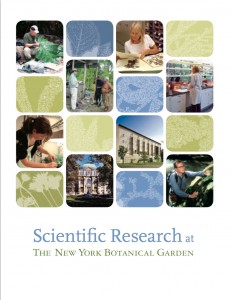New Book Profiles Garden’s Botanical Science Research
Posted in Science on May 27 2009, by Plant Talk
 |
Brian M. Boom, Ph.D., is Special Assistant to the President and Director of the Caribbean Biodiversity Program at the Garden. |
 I have been around The New York Botanical Garden and involved in its scientific enterprise in one way or another for nearly three decades. Until now there has never been a publication as comprehensive as the one released last month that provides an overview of how the Botanical Garden’s scientific mission is realized. Scientific Research at The New York Botanical Garden features beautiful full-color photographs of work conducted both in the field and laboratory with informative text about current projects and facilities. It can currently be downloaded online.
I have been around The New York Botanical Garden and involved in its scientific enterprise in one way or another for nearly three decades. Until now there has never been a publication as comprehensive as the one released last month that provides an overview of how the Botanical Garden’s scientific mission is realized. Scientific Research at The New York Botanical Garden features beautiful full-color photographs of work conducted both in the field and laboratory with informative text about current projects and facilities. It can currently be downloaded online.
Following the Preface by the Chairmen of the Garden’s Botanical Science Committee, Edward P. Bass and George M. Milne, Jr., Ph.D., and Introduction by James S. Miller, Ph.D., Dean and Vice President for Science, the book is organized as Research Facilities and Collections; Research Programs and Projects; Faculty Research Profiles; Results Shared with the World; and Training, Science Education, and Collaboration, including lists of selected research grants and faculty publications.
One of the best ways to get to the heart of the Garden’s scientific activities is to browse through the research profiles of the 32 Ph.D. faculty members who comprise the core of the Garden’s scientific staff and who are assisted in their programs and projects by postdoctoral researchers and doctoral students. The team is further enhanced by Honorary Curators and Research Fellows and hundreds of additional local, national, and international collaborators.
Readers will learn about the state-of-the-art research and collections facilities located on a 23-acre science campus within the Garden’s 250-acre landmark grounds as well as in far-flung field locations around the world. Research results, many serving to inform plant conservation and sustainable development policies, are regularly disseminated through books and journals of The New York Botanical Garden Press and increasingly via electronic catalogs and publications available from our C.V. Starr Virtual Herbarium.
For those who want to discover even more, consider attending special lectures and symposia offered by the Garden, signing up for a Continuing Education class, or participating in the ecotour Ten Days in Brazil (October 10–21, 2009). Readers inspired to support the Garden’s scientific activities by volunteering and/or making a donation can learn how by clicking here.

